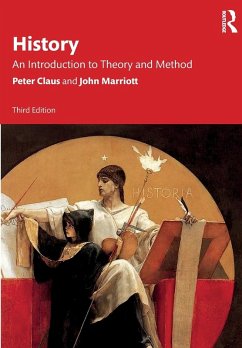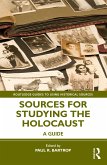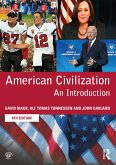- Broschiertes Buch
- Merkliste
- Auf die Merkliste
- Bewerten Bewerten
- Teilen
- Produkt teilen
- Produkterinnerung
- Produkterinnerung
This book provides an accessible introduction to a wide range of concerns that have preoccupied historians over time. Global in scope, it explores historical perspectives not only from historiography itself but from related areas such as literature, sociology, geography and anthropology which have entered into productive dialogues with history.
Clearly written and accessible, this third edition is fully revised with an updated structure and new areas of historical enquiry and themes added, including the history of emotions, video history and global pandemics. In all of this, the authors…mehr
Andere Kunden interessierten sich auch für
![Fifty Key Works of History and Historiography Fifty Key Works of History and Historiography]() Kenneth Stunkel (USA Monmouth University)Fifty Key Works of History and Historiography42,99 €
Kenneth Stunkel (USA Monmouth University)Fifty Key Works of History and Historiography42,99 €![Britain since 1688 Britain since 1688]() Stephanie BarczewskiBritain since 168842,99 €
Stephanie BarczewskiBritain since 168842,99 €![Sources for Studying the Holocaust Sources for Studying the Holocaust]() Sources for Studying the Holocaust38,99 €
Sources for Studying the Holocaust38,99 €![Computer Computer]() Martin Campbell-KellyComputer38,99 €
Martin Campbell-KellyComputer38,99 €![American Civilization American Civilization]() David MaukAmerican Civilization40,99 €
David MaukAmerican Civilization40,99 €![The Public History Reader The Public History Reader]() The Public History Reader72,99 €
The Public History Reader72,99 €![History from Loss History from Loss]() History from Loss41,99 €
History from Loss41,99 €-
-
-
This book provides an accessible introduction to a wide range of concerns that have preoccupied historians over time. Global in scope, it explores historical perspectives not only from historiography itself but from related areas such as literature, sociology, geography and anthropology which have entered into productive dialogues with history.
Clearly written and accessible, this third edition is fully revised with an updated structure and new areas of historical enquiry and themes added, including the history of emotions, video history and global pandemics. In all of this, the authors have attempted to think beyond the boundaries of the West and consider varied approaches to history. They do so by engaging with theoretical perspectives and methodologies that have provided the foundation for good historical practice. The authors analyse how historians can improve their skills by learning about the discipline of historiography, that is, how historians go about the task of exploring the past and determining where the line separating history from other disciplines, such as sociology or geography, runs.
History: An Introduction to Theory and Method 3ed is an essential resource for students of historical theory and method working at both an introductory and more advanced level.
Clearly written and accessible, this third edition is fully revised with an updated structure and new areas of historical enquiry and themes added, including the history of emotions, video history and global pandemics. In all of this, the authors have attempted to think beyond the boundaries of the West and consider varied approaches to history. They do so by engaging with theoretical perspectives and methodologies that have provided the foundation for good historical practice. The authors analyse how historians can improve their skills by learning about the discipline of historiography, that is, how historians go about the task of exploring the past and determining where the line separating history from other disciplines, such as sociology or geography, runs.
History: An Introduction to Theory and Method 3ed is an essential resource for students of historical theory and method working at both an introductory and more advanced level.
Produktdetails
- Produktdetails
- Verlag: Routledge / Taylor & Francis
- 3. Aufl.
- Seitenzahl: 518
- Erscheinungstermin: 7. Juli 2023
- Englisch
- Abmessung: 244mm x 170mm x 28mm
- Gewicht: 1000g
- ISBN-13: 9780367740955
- ISBN-10: 0367740958
- Artikelnr.: 67516100
- Herstellerkennzeichnung
- Libri GmbH
- Europaallee 1
- 36244 Bad Hersfeld
- gpsr@libri.de
- Verlag: Routledge / Taylor & Francis
- 3. Aufl.
- Seitenzahl: 518
- Erscheinungstermin: 7. Juli 2023
- Englisch
- Abmessung: 244mm x 170mm x 28mm
- Gewicht: 1000g
- ISBN-13: 9780367740955
- ISBN-10: 0367740958
- Artikelnr.: 67516100
- Herstellerkennzeichnung
- Libri GmbH
- Europaallee 1
- 36244 Bad Hersfeld
- gpsr@libri.de
Dr Peter Claus is an Access Fellow, Director of OxNet & CredOx at Pembroke College, Oxford. He is currently writing a book on the 'East End Underworld' in the twentieth century co-authored with John Marriott, also for Routledge. The combination of Access activities and historical research has developed an historical interest in the metropolis and a commitment to research on outreach, education theory and practice, public engagement, and the democratisation of the archive. Professor John Marriott is Visiting Fellow at Kellogg College, Oxford. His research has focused on London and Empire from the seventeenth century. Among numerous books are Beyond the Tower: A History of East London (2011). He is currently editing a major digital resource on the nineteenth-century British Empire, and completing a study of the origins of British territorial power in India.
Part 1: Philosophies 1. From the ancients to the Christians 2. From the Middle Ages to the Early Modern 3. Enlightenment and Romanticism 4. The English Tradition 5. The North American Tradition 6. Histories of Revolutions; Revolutionary histories 7. Postmodernism and Postcolonialism Part 2: Varieties 8. Political History 9. Economic History 10. Social History 11. Cultural History 12. Feminism, Gender and Queer History 13. Public History 14. Visual History 15. Global history 16. Environmental history Part 3: Interdisciplinarities 17. Archaeology 18. Anthropology 19. Literature 20. Geography Part 4: Methods 21. Proof and the problem of objectivity 22. Ordering of time 23. Archives in a Digital World 24. Oral History
List of figures
List of tables
Prologue: history matters
Acknowledgements
THEORY
Part 1 Perspectives
Chapter 1: Proof, objectivity and causality
1. History: science or art?
2. The status of historical knowledge
3. Evidence and interpretation
4. Causes in history
Chapter 2: Ordering of time
1. Time, history, modernity
2. Newton and the 'time reckoner'
3. Periodization
4. The shape of things to come
Part 2 Histories and Philosophies
Chapter 3: Ideas of History; from the ancients to the Christians
1. Herodotus and gold-digging ants
2. Thucydides and reason: an historian for our times?
3. What did the Romans ever do for history?
4. Christianity and the end of days
Chapter 4: From the Middle Ages to the Early Modern
1. European Christendom and the age of Bede
2. Peoples of the book: Jewish and Islamic conceptions of history
3. Renaissance humanism and rediscovery of the classics
4. The battle of books: Camden, Clarendon and English identity
Chapter 5: Enlightenment and Romanticism
1. The English Enlightenment?
2. Secular histories
3. Romanticism: Scott and Carlyle
Chapter 6: The English Tradition
1. Responses to the Enlightenment: Edmund Burke
2. Constitutionalism and the Whig interpretation of history
3. JH Plumb and the new Whigs
Chapter 7: The North American Tradition
1. America and the New Order of the Ages
2. The progressive or new historians
3. The consensus historians
4. The other America
Chapter 8: Histories of Revolutions; Revolutionary histories
1. Paine and the radical tradition
2. French and German Experiences
3. Germany, Hegel and the Spirit of History
4. Marx and 'historical materialism'
5. Marxism in the twentieth century
Chapter 9: Postmodernism and Postcolonialism
1. Modernity and the Enlightenment
2. Postmodernism
3. Postcolonialism and the West
METHOD
Part 3 Varieties
Chapter 10: Political History
1. Theories of the state
2. High and low politics: the case of the British Labour Party
3. Beyond state and party: political histories and civil society
Chapter 11: Economic History
1. Population and social change
2. Economic historians and the big historical questions
3. The business of business history
Chapter 12: Social History
1. The emergence of social history
2. Class and authority
3. The family in history
Chapter 13: Cultural History
1. What is cultural history?
2. The national character
3. The promise of cultural history: conflict and carnival
Chapter 14: Feminism, Gender and Women's History
1. Feminism and history
2. The attack on class
3. Gender and identity
Chapter 15: Public History
1. What is public about history?
2. Consumption of public history
3. Producing public history
4. Public history as contested knowledge
Chapter 16: Visual History
1. Visual histories
2. Ways of seeing: Paintings
3. Ways of seeing: Prints and photographs
Chapter 17: Global history
1. The challenges of global history
2. Origins of the global imagination
3. Enter 'new world history'
Chapter 18: Environmental history
1. The scope of environmental history
2. Historic precedents
3. European colonialism
4. Modern environmentalism
Part 4 History and Other Disciplines
Chapter 19: Archaeology
1. The lure of archaeology
2. The theoretical turn: Collingwood and Childe
3. Historical archaeology
4. Jerusalem and its layers
Chapter 20: Anthropology
1. Pens and pith helmets
2. Functionalism and structuralism
3. Historical myths: Jewish conspiracies and the 'blood libel'
4. The 'dying god': Captain Cook and ethnohistory
5. Microhistories: worms, night battles and ecstasies
Chapter 21: Literature
1. Literature as history
2. The new historicism: Text and context
3. The graphic novel
4. Writing the metropolis
Chapter 22: Geography
1. History, space and place
2. Geographies of empire
3. How to lie with maps
PRACTICE
Chapter 23: Archives in a Digital World
1. What is an archive?
2. 'When we return as human beings again': archives and the ashes
3. Speaking for ourselves: state and community archives
4. Archives and the digital turn
Chapter 24: Oral History
1. Anthropologists of ourselves
2. Oral historiographies
3. The limits of memory: Arthur Harding and the East End underworld
4. The wider experience
Bibliography
Index
List of tables
Prologue: history matters
Acknowledgements
THEORY
Part 1 Perspectives
Chapter 1: Proof, objectivity and causality
1. History: science or art?
2. The status of historical knowledge
3. Evidence and interpretation
4. Causes in history
Chapter 2: Ordering of time
1. Time, history, modernity
2. Newton and the 'time reckoner'
3. Periodization
4. The shape of things to come
Part 2 Histories and Philosophies
Chapter 3: Ideas of History; from the ancients to the Christians
1. Herodotus and gold-digging ants
2. Thucydides and reason: an historian for our times?
3. What did the Romans ever do for history?
4. Christianity and the end of days
Chapter 4: From the Middle Ages to the Early Modern
1. European Christendom and the age of Bede
2. Peoples of the book: Jewish and Islamic conceptions of history
3. Renaissance humanism and rediscovery of the classics
4. The battle of books: Camden, Clarendon and English identity
Chapter 5: Enlightenment and Romanticism
1. The English Enlightenment?
2. Secular histories
3. Romanticism: Scott and Carlyle
Chapter 6: The English Tradition
1. Responses to the Enlightenment: Edmund Burke
2. Constitutionalism and the Whig interpretation of history
3. JH Plumb and the new Whigs
Chapter 7: The North American Tradition
1. America and the New Order of the Ages
2. The progressive or new historians
3. The consensus historians
4. The other America
Chapter 8: Histories of Revolutions; Revolutionary histories
1. Paine and the radical tradition
2. French and German Experiences
3. Germany, Hegel and the Spirit of History
4. Marx and 'historical materialism'
5. Marxism in the twentieth century
Chapter 9: Postmodernism and Postcolonialism
1. Modernity and the Enlightenment
2. Postmodernism
3. Postcolonialism and the West
METHOD
Part 3 Varieties
Chapter 10: Political History
1. Theories of the state
2. High and low politics: the case of the British Labour Party
3. Beyond state and party: political histories and civil society
Chapter 11: Economic History
1. Population and social change
2. Economic historians and the big historical questions
3. The business of business history
Chapter 12: Social History
1. The emergence of social history
2. Class and authority
3. The family in history
Chapter 13: Cultural History
1. What is cultural history?
2. The national character
3. The promise of cultural history: conflict and carnival
Chapter 14: Feminism, Gender and Women's History
1. Feminism and history
2. The attack on class
3. Gender and identity
Chapter 15: Public History
1. What is public about history?
2. Consumption of public history
3. Producing public history
4. Public history as contested knowledge
Chapter 16: Visual History
1. Visual histories
2. Ways of seeing: Paintings
3. Ways of seeing: Prints and photographs
Chapter 17: Global history
1. The challenges of global history
2. Origins of the global imagination
3. Enter 'new world history'
Chapter 18: Environmental history
1. The scope of environmental history
2. Historic precedents
3. European colonialism
4. Modern environmentalism
Part 4 History and Other Disciplines
Chapter 19: Archaeology
1. The lure of archaeology
2. The theoretical turn: Collingwood and Childe
3. Historical archaeology
4. Jerusalem and its layers
Chapter 20: Anthropology
1. Pens and pith helmets
2. Functionalism and structuralism
3. Historical myths: Jewish conspiracies and the 'blood libel'
4. The 'dying god': Captain Cook and ethnohistory
5. Microhistories: worms, night battles and ecstasies
Chapter 21: Literature
1. Literature as history
2. The new historicism: Text and context
3. The graphic novel
4. Writing the metropolis
Chapter 22: Geography
1. History, space and place
2. Geographies of empire
3. How to lie with maps
PRACTICE
Chapter 23: Archives in a Digital World
1. What is an archive?
2. 'When we return as human beings again': archives and the ashes
3. Speaking for ourselves: state and community archives
4. Archives and the digital turn
Chapter 24: Oral History
1. Anthropologists of ourselves
2. Oral historiographies
3. The limits of memory: Arthur Harding and the East End underworld
4. The wider experience
Bibliography
Index
Part 1: Philosophies 1. From the ancients to the Christians 2. From the Middle Ages to the Early Modern 3. Enlightenment and Romanticism 4. The English Tradition 5. The North American Tradition 6. Histories of Revolutions; Revolutionary histories 7. Postmodernism and Postcolonialism Part 2: Varieties 8. Political History 9. Economic History 10. Social History 11. Cultural History 12. Feminism, Gender and Queer History 13. Public History 14. Visual History 15. Global history 16. Environmental history Part 3: Interdisciplinarities 17. Archaeology 18. Anthropology 19. Literature 20. Geography Part 4: Methods 21. Proof and the problem of objectivity 22. Ordering of time 23. Archives in a Digital World 24. Oral History
List of figures
List of tables
Prologue: history matters
Acknowledgements
THEORY
Part 1 Perspectives
Chapter 1: Proof, objectivity and causality
1. History: science or art?
2. The status of historical knowledge
3. Evidence and interpretation
4. Causes in history
Chapter 2: Ordering of time
1. Time, history, modernity
2. Newton and the 'time reckoner'
3. Periodization
4. The shape of things to come
Part 2 Histories and Philosophies
Chapter 3: Ideas of History; from the ancients to the Christians
1. Herodotus and gold-digging ants
2. Thucydides and reason: an historian for our times?
3. What did the Romans ever do for history?
4. Christianity and the end of days
Chapter 4: From the Middle Ages to the Early Modern
1. European Christendom and the age of Bede
2. Peoples of the book: Jewish and Islamic conceptions of history
3. Renaissance humanism and rediscovery of the classics
4. The battle of books: Camden, Clarendon and English identity
Chapter 5: Enlightenment and Romanticism
1. The English Enlightenment?
2. Secular histories
3. Romanticism: Scott and Carlyle
Chapter 6: The English Tradition
1. Responses to the Enlightenment: Edmund Burke
2. Constitutionalism and the Whig interpretation of history
3. JH Plumb and the new Whigs
Chapter 7: The North American Tradition
1. America and the New Order of the Ages
2. The progressive or new historians
3. The consensus historians
4. The other America
Chapter 8: Histories of Revolutions; Revolutionary histories
1. Paine and the radical tradition
2. French and German Experiences
3. Germany, Hegel and the Spirit of History
4. Marx and 'historical materialism'
5. Marxism in the twentieth century
Chapter 9: Postmodernism and Postcolonialism
1. Modernity and the Enlightenment
2. Postmodernism
3. Postcolonialism and the West
METHOD
Part 3 Varieties
Chapter 10: Political History
1. Theories of the state
2. High and low politics: the case of the British Labour Party
3. Beyond state and party: political histories and civil society
Chapter 11: Economic History
1. Population and social change
2. Economic historians and the big historical questions
3. The business of business history
Chapter 12: Social History
1. The emergence of social history
2. Class and authority
3. The family in history
Chapter 13: Cultural History
1. What is cultural history?
2. The national character
3. The promise of cultural history: conflict and carnival
Chapter 14: Feminism, Gender and Women's History
1. Feminism and history
2. The attack on class
3. Gender and identity
Chapter 15: Public History
1. What is public about history?
2. Consumption of public history
3. Producing public history
4. Public history as contested knowledge
Chapter 16: Visual History
1. Visual histories
2. Ways of seeing: Paintings
3. Ways of seeing: Prints and photographs
Chapter 17: Global history
1. The challenges of global history
2. Origins of the global imagination
3. Enter 'new world history'
Chapter 18: Environmental history
1. The scope of environmental history
2. Historic precedents
3. European colonialism
4. Modern environmentalism
Part 4 History and Other Disciplines
Chapter 19: Archaeology
1. The lure of archaeology
2. The theoretical turn: Collingwood and Childe
3. Historical archaeology
4. Jerusalem and its layers
Chapter 20: Anthropology
1. Pens and pith helmets
2. Functionalism and structuralism
3. Historical myths: Jewish conspiracies and the 'blood libel'
4. The 'dying god': Captain Cook and ethnohistory
5. Microhistories: worms, night battles and ecstasies
Chapter 21: Literature
1. Literature as history
2. The new historicism: Text and context
3. The graphic novel
4. Writing the metropolis
Chapter 22: Geography
1. History, space and place
2. Geographies of empire
3. How to lie with maps
PRACTICE
Chapter 23: Archives in a Digital World
1. What is an archive?
2. 'When we return as human beings again': archives and the ashes
3. Speaking for ourselves: state and community archives
4. Archives and the digital turn
Chapter 24: Oral History
1. Anthropologists of ourselves
2. Oral historiographies
3. The limits of memory: Arthur Harding and the East End underworld
4. The wider experience
Bibliography
Index
List of tables
Prologue: history matters
Acknowledgements
THEORY
Part 1 Perspectives
Chapter 1: Proof, objectivity and causality
1. History: science or art?
2. The status of historical knowledge
3. Evidence and interpretation
4. Causes in history
Chapter 2: Ordering of time
1. Time, history, modernity
2. Newton and the 'time reckoner'
3. Periodization
4. The shape of things to come
Part 2 Histories and Philosophies
Chapter 3: Ideas of History; from the ancients to the Christians
1. Herodotus and gold-digging ants
2. Thucydides and reason: an historian for our times?
3. What did the Romans ever do for history?
4. Christianity and the end of days
Chapter 4: From the Middle Ages to the Early Modern
1. European Christendom and the age of Bede
2. Peoples of the book: Jewish and Islamic conceptions of history
3. Renaissance humanism and rediscovery of the classics
4. The battle of books: Camden, Clarendon and English identity
Chapter 5: Enlightenment and Romanticism
1. The English Enlightenment?
2. Secular histories
3. Romanticism: Scott and Carlyle
Chapter 6: The English Tradition
1. Responses to the Enlightenment: Edmund Burke
2. Constitutionalism and the Whig interpretation of history
3. JH Plumb and the new Whigs
Chapter 7: The North American Tradition
1. America and the New Order of the Ages
2. The progressive or new historians
3. The consensus historians
4. The other America
Chapter 8: Histories of Revolutions; Revolutionary histories
1. Paine and the radical tradition
2. French and German Experiences
3. Germany, Hegel and the Spirit of History
4. Marx and 'historical materialism'
5. Marxism in the twentieth century
Chapter 9: Postmodernism and Postcolonialism
1. Modernity and the Enlightenment
2. Postmodernism
3. Postcolonialism and the West
METHOD
Part 3 Varieties
Chapter 10: Political History
1. Theories of the state
2. High and low politics: the case of the British Labour Party
3. Beyond state and party: political histories and civil society
Chapter 11: Economic History
1. Population and social change
2. Economic historians and the big historical questions
3. The business of business history
Chapter 12: Social History
1. The emergence of social history
2. Class and authority
3. The family in history
Chapter 13: Cultural History
1. What is cultural history?
2. The national character
3. The promise of cultural history: conflict and carnival
Chapter 14: Feminism, Gender and Women's History
1. Feminism and history
2. The attack on class
3. Gender and identity
Chapter 15: Public History
1. What is public about history?
2. Consumption of public history
3. Producing public history
4. Public history as contested knowledge
Chapter 16: Visual History
1. Visual histories
2. Ways of seeing: Paintings
3. Ways of seeing: Prints and photographs
Chapter 17: Global history
1. The challenges of global history
2. Origins of the global imagination
3. Enter 'new world history'
Chapter 18: Environmental history
1. The scope of environmental history
2. Historic precedents
3. European colonialism
4. Modern environmentalism
Part 4 History and Other Disciplines
Chapter 19: Archaeology
1. The lure of archaeology
2. The theoretical turn: Collingwood and Childe
3. Historical archaeology
4. Jerusalem and its layers
Chapter 20: Anthropology
1. Pens and pith helmets
2. Functionalism and structuralism
3. Historical myths: Jewish conspiracies and the 'blood libel'
4. The 'dying god': Captain Cook and ethnohistory
5. Microhistories: worms, night battles and ecstasies
Chapter 21: Literature
1. Literature as history
2. The new historicism: Text and context
3. The graphic novel
4. Writing the metropolis
Chapter 22: Geography
1. History, space and place
2. Geographies of empire
3. How to lie with maps
PRACTICE
Chapter 23: Archives in a Digital World
1. What is an archive?
2. 'When we return as human beings again': archives and the ashes
3. Speaking for ourselves: state and community archives
4. Archives and the digital turn
Chapter 24: Oral History
1. Anthropologists of ourselves
2. Oral historiographies
3. The limits of memory: Arthur Harding and the East End underworld
4. The wider experience
Bibliography
Index








